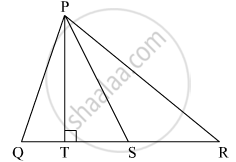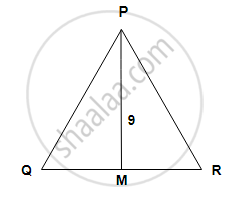Advertisements
Advertisements
Question
Choose the correct alternative:
Out of given triplets, which is not a Pythagoras triplet?
Options
(9, 40, 41)
(11, 60, 61)
(6, 14, 15)
(6, 8, 10)
Solution
(6, 14, 15)
Here, 152 = 225
62 + 142 = 36 + 196 = 232
∴ 152 ≠ 62 + 142
The square of the largest number is not equal to the sum of the squares of the other two numbers.
∴(6, 14, 15) is not a Pythagoras triplet.
APPEARS IN
RELATED QUESTIONS
Adjacent sides of a parallelogram are 11 cm and 17 cm. If the length of one of its diagonal is 26 cm, find the length of the other.
In the given figure, seg PS is the median of ∆PQR and PT ⊥ QR. Prove that,
PR2 = PS2 + QR × ST + `("QR"/2)^2`

Some question and their alternative answer are given.
In a right-angled triangle, if sum of the squares of the sides making right angle is 169 then what is the length of the hypotenuse?
Some question and their alternative answer are given. Select the correct alternative.
Altitude on the hypotenuse of a right angled triangle divides it in two parts of lengths 4 cm and 9 cm. Find the length of the altitude.
Some question and their alternative answer are given. Select the correct alternative.
In ∆ABC, AB = \[6\sqrt{3}\] cm, AC = 12 cm, BC = 6 cm. Find measure of ∠A.
Find the height of an equilateral triangle having side 2a.
Do sides 7 cm, 24 cm, 25 cm form a right angled triangle ? Give reason
Seg PM is a median of ∆PQR. If PQ = 40, PR = 42 and PM = 29, find QR.
Choose the correct alternative:
Out of the following which is a Pythagorean triplet?
In ΔPQR, seg PM is the median. If PM = 9, PQ2 + PR2 = 290, Find QR.

Choose the correct alternative:
Out of given triplets, which is not a Pythagoras triplet?
Choose the correct alternative:
Out of all numbers from given dates, which is a Pythagoras triplet?
Height and base of a right angled triangle are 24 cm and 18 cm. Find the length of its hypotenus?
"The diagonals bisect each other at right angles." In which of the following quadrilaterals is the given property observed?
Which of the following figure is formed by joining the mid-points of the adjacent sides of a square?
